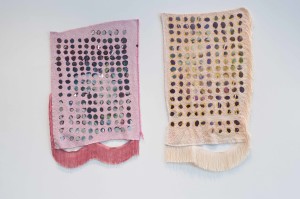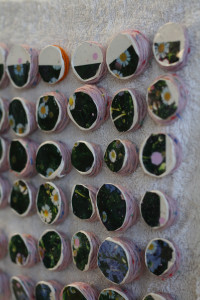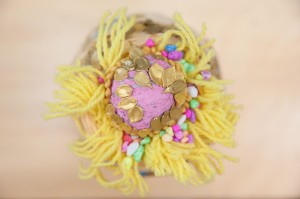Exhibition: PAINTFACE You Reckless Bath Towel, Art Pod – 20 November – 30 January
Mae Finlayson graced Adelaide with her presence and her textiley goodness, so in-between projects I snuck some of her time (and some of her strawberries) to reflect on the new body of work she has developed for PAINTFACE. Having worked tirelessly all year, experimenting with paint and material Mae stepped up to the challenge taking over Adelaide’s Art Pod with three-dimensional paintings that spin at will, bath towel certificates and yarn trophies.
What do you love about living and working in Launceston? I love the house that we’ve got, and the people, and the Gorge, and definitely the support for creativity there. I really enjoy teaching at the Uni (UTAS), and being involved with Sawtooth ARI, and interesting things come up all the time!
Where do you source your materials from mostly? Mostly from donations to me or to the textile studio at UTAS or op shops, markets, Spotlight. I don’t strictly use used materials but when they’re new I will often buy end of the line stock, so in a way it is kind of unwanted or on its way out.
Why do you choose ‘used’? Especially with the towels, which are something I’ve started working with, I like that they are used because they have a very human element to them. They’ve been handled and people have lived with them and that’s important for my work because I want my work to feel human and be easy to relate to.
What do the towels mean to you? The towels are great because they’ve been… I’m reading this book about reading history through objects, which is a kind of newish idea because Historians have mostly looked to texts but now objects are being read. I’m currently reading about them finding bundled clothes in very old European houses that have been hidden inside wall cavities and chimneys for hundreds or thousands of years. Now they’re trying to work out why they’re there. Perhaps for historically superstitious reasons, but then I was thinking, well I can read history through the bath towels. Through the holes and wear you can decipher more of a contemporary everyday recent history.

I love what you said the other day about your Show Towels being like a reward for getting up this morning… I’m using them as frames, because they have been pre ripped up for ‘rags’, they come in wonky certificate sizes, so by having them on the wall and putting fringing on them they become a crossover of banner, framed certificate or badge-like – with the circle embellishments that I’ve added. I want them to have a celebratory feel and congratulations for getting up and having a shower but then so much can come from that, everyone can do that [get up and have a shower] but then they all go off and can achieve their own personal goals and life achievements.
You do collaboration a lot but for this specific project how did collaboration play a part? I would have liked it to be more of a collaboration and perhaps collaborated on more works but it’s not something you can force. I’m not sure if the piece that does have some of Grant’s work and some of my work in it… where you’d put that on the collaboration scale? I went to Grant’s studio and picked up some discarded material from the floor, which was an acetate film, which he had projected up and made a painting of but now it was rubbish to him, or he didn’t need it anymore – it had had its use. So I asked if I could have that and then I brought it back and made my circle sequins out of it and mounted them onto a bath towel. So that we had both of our work and practice exhibited in one piece.

The title of that work: This Towel Has Daises…? Yes because the imagery, Grant’s imagery, was from a photo he’d taken in a garden of daisies and the daisies really stand out a lot on the towel background. I raised them up and it’s quite a 3D work. The method or technique is reminiscent of Shisha, which is a traditional Indian mirror work where they trap down the little circled mirrors, but it’s kind of my own version of Shisha.
Tell me about the work that you’ve made for PAINTFACE You Reckless Bath Towel. We’ve talked about the bath towel works… At least four of the other pieces are found unfinished needlepoint craft projects, where the making has been started and then stopped for reasons that I can only guess at. They’ve been donated or given to op shops, rather than ‘thrown’ out – they weren’t worthless. From my own experience and from speaking to others, I’ve found that you may have an unfinished craft project stored away for years; something is stopping you from finishing it. So I’ve collected those and then I’ve added to them. They’re still unfinished projects but I think of them as ‘anonymous collaborations’. This is what my current PhD is looking at. I haven’t figured out exactly why or how the collaboration works, or if I can even call it collaboration if one party isn’t aware of the project at all.
It’s interesting as well with that and talking about the history of the object, again there’s history with that object, it’s been lived with… Yeah and I’m hoping to hypothesise about that history by looking at the unfinishedness. Is it unfulfilled achievement or frustration? But not just the negative, it could be a positive, I’m sure people stopped because it was probably a pretty boring activity, there’s really no creativity left in those paint/stitch by number things. I hope that they put it down and went off to achieve something more constructive and more fun! I’m also thinking about how the unfinished project has a sense of suspended achievement within it. Once you get to an end result that sense of aspiring to something is over.
The thing that comes up for me when you talk about your work is the playfulness and the element of (and I think this is telling of your personality) cheekiness. Particularly with your lions mane in your work called Challenge – it’s just fun! You’ve chosen to work with materials and a particular palette that is quite unconventional. I hope they’re serious as well but it’s really important to have that sense of playfulness. The serious or dark side of that work is that it is a Stubbs painting transferred into a needlepoint and it depicts a lion attacking a horse. It is gruesome! But yeah, I gave the lion googly eyes and a big blue metallic shiny mane.
For me, these materials bring up associations to childhood and memories of making pet rocks, teddy bear picnics and other child play. It’s really important to have a good dose of ‘the familiar’ in the work because I want people to get it, or at least recognise some part of it, straight away.

There’s intimate detailing that you can’t see unless you get close to it. Like the other day when we were talking about the stalactites and stalagmites in some of the painted beads you’ve made and pinned to one of your totem sculptures. Yes!So everything that’s in the PAINTFACE show, especially those cone totems or trophy sculptures – all the detailing on them is pinned. I work a lot with impermanent placement of stuff so they can be taken apart and added somewhere else. When I got here I really didn’t know how they were going to look. I had all the bits and played with them and then I’m going to take them back to Tas and do that again, maybe add more stuff?
How have you found working with paint and do you want to do it again? Working with paint was good, it was a challenge and I really enjoyed having the challenge. I’m glad that I didn’t try and paint an oil painting or anything like that because I’m not a painter and it would be silly to try and learn something completely new in a short period of time. So I used paint as I use everything, as a material. I turned it into beads, sequins, skins, fabric, and I’ve got lots of those experiments still in the studio. Exciting discoveries like putting paint onto baking paper and letting it dry out and peeling it off so that you can have a solid stroke of paint that’s just supporting itself. I think there’s a lot more that I can do with those materials.
I think that’s what’s interesting just in this conversation is that the history of the object and the history of painting, is so huge and you’ve almost tackled both those areas head on in this project, in your own way. It takes the work to another level then. I guess stereotypically painting has been a male genre so I liked putting the paint onto the yarn and cones of yarn, which were stereotypically woman’s materials.
But also the paint that you’ve used is often pink or gold, which are quite feminine and glamourous colours. Mmm… yep!
Well, congratulations Mae! Congratulations Polly! Good project! Good work!
[Strawberry cheers]